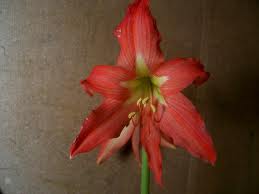Hippeastrum
Pot Cultivation
Hippeastrums are hardy from zones 7 to 11. They may be grown as houseplants in cool regions. Choose a sunny or lightly shaded location for your bulbs. They should be planted in well-drained, sandy, organic soil (such as one part leaf mold or peat moss, one part well-decayed manure, with a bit of coarse sand and bone meal added) about 8 inches deep and at least a foot apart, in the spring or winter. They should be watered regularly after the foliage emerges; sparingly in the winter. Take care not to overwater as the bulbs will rot. When growing in containers, a 6-inch pot should be used for each large bulb. Medium-sized bulbs can be planted in 5-inch pots. A third of the bulb should be showing above the container's rim. Set the pot in a 70� F room in bright light. The production of flowers reduces the size of the bulbs greatly, so as soon as the flowers have faded, liquid fertilizer should be applied. In the fall, when growth has stopped, the water supply should be diminished gradually as the leaves fade. Throughout the winter, the pots should be laid on their sides in 50�F temperatures and kept fairly dry, making sure that the bulbs don't shrivel up.Propagation
Offsets or small bulbs can be taken off and potted in 3-inch pots. They'll flower in two or three years. Seeds may also be sown in April or May, in well-drained pots of sandy loam. The pots should be placed in a warm propagating case. In about 4 weeks the seedlings can be potted individually and set in a warm, brightly lit area, such as a windowsill or outside in bright shade. They may be covered with plastic bags to maintain humidity until they've formed their second set of leaves. If fertilized generously and given proper protection, it may only take seedlings two years or less to reach flowering size. |
|
H. striatum |
SOME SPECIES:
- H. evansiae (yellow);
- H. striatum;
- H. aulicum;
- H. Leopoldii (crimson & white);
- H. vittatum (crimson);
- H. reticulatum (rose);
- H. pardinum (green, yellow & scarlet);
- H. puniceum (orange-red or salmon-red);
- H. psittacinum (orange & scarlet);
- H. johnsonii;
- H. reginae. (There are many more species and numerous hybrids available.)




